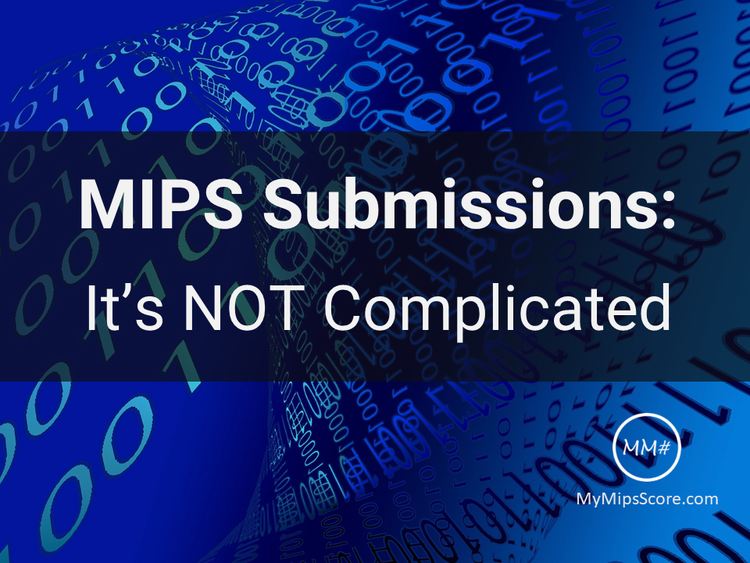This is a guest post by Pawan Jindal of MyMIPSScore and originally appeared at the MyMIPSScore Blog
It is hard to believe that we are already in the last quarter of 2017. Even as the first year of MIPS winds down, complaints about how complicated MIPS is, continue to dominate the news. Over the past nine months, we have posted multiple blogs to help simplify MIPS for you and provide guidance on how to excel under MIPS. In this post however, we are going to take a step back and compare MIPS submissions with submission to CMS under the previous programs.

How Submissions Worked Pre-MIPS
Let’s review what most of you had been doing for last couple of years under Meaningful Use and PQRS programs.
MEANINGFUL USE SUBMISSION
- You had to complete a Security Risk Analysis (SRA)
- Export the Meaningful Use report from your EHR
- Login to the CMS Attestation portal and enter the data for each provider separately. You had to enter the data for all the measures to “meet the requirements”.
- After entering the MU data, you had to choose one of the two options for reporting your CQMs:
- Option-1:You could report the full year data for 9 measures by posting a submission file (QRDA I or QRDAIII) created from your certified EHR to the Quality Net Portal. The nine measures had to cover at least three domains, and had to meet some performance rate requirements. If your EHR supported that, your work was done. If not, you had to take the option-2, and do a separate PQRS submission.
- Option-2: Enter the certified eCQM data manually from your EHR for the 9 Quality measures covering at least three domains for 90 days during the Meaningful Use Attestation. There were no minimum performance rate requirements but you had to complete a PQRS submission separately.
PQRS SUBMISSION
If you chose Option-2 for CQMs above, you had to do one of the following to meet the PQRS requirements:
- Report quality data through G codes on your claims.
- Work with a registry to extract the data from your claims, or by some other Registry-directed method and submit it to CMS.
The CQM submission methods mentioned above had no immediate feedback mechanism. Providers had to wait for about 8 months after submission for the QRUR reports to be generated, and get feedback on their performance.
Changes Under MIPS
MIPS combined the PQRS and the Meaningful Use into a single program. Under MIPS, PQRS got a shorter name of Quality category and Meaningful Use got a new fancy name of Advancing Care Information(ACI). MIPS also added a new category called Improvement Activities. Other than the changes in nomenclature, MIPS introduced the following key changes for 2017:
- Allowed submission of Quality data for only 90 days vs full year.
- Allowed submission of Quality data for only 6 measures vs 9 measures required.
- Removed the requirement that quality measures must span three domains.
- Removed the requirement to report on ONLY Medicare Part-B patients (except for Claims submission. It’s now reporting on at least 50% of All Patients for All Payers.
- Allowed to meet the ACI requirements by submitting data on fewer measures versus an all or none approach before.
- Allowed providers to submit aggregated data at a group level for ACI.
Submission Simplifications Under MIPS
Based on the pace you decide to pick, there are additional flexibilities allowed if you want to just avoid the penalty, or “meet the requirements” to be eligible for a positive payment adjustment:
- You can report on only one Quality measure for a single Medicare Part-B patient; OR
- You can report on four required ACI measures for 90 days; OR
- You can report on one Improvement Activity for 90 days.
Note that there is an “OR” between the three options above, which means that you can meet the requirements even without reporting any quality data.
That is NOT COMPLICATED. In fact, these are significant simplifications to the previous requirements. However, the most significant change under MIPS is the actual submission process introduced by CMS. This new submission process allows you to get instant feedback on your submission. You can read more about this new submission process here.
SO, WHAT EXACTLY DO YOU NEED TO DO TO SUBMIT DATA FOR MIPS?
Here is one way to go about it:
- Download the list of Improvement Activities from CMS. Review the documentation requirements, and select the activities for which you fulfilled the requirements and can support the requisite documentation for any 90 consecutive days.
- Go to your EHR, and print a copy of your MU dashboard for any 90 consecutive days
- Go to the EHR Quality Reporting dashboard in your EHR, and run a report for any 90 consecutive days for any measures supported by your EHR.
As discussed earlier, you can choose to do just one of the above-mentioned steps (or even part of it) and submit MIPS data for just one performance category.
Once you have all the required data, you can choose one of the following to actually submit the data:
- Work with a MIPS submission vendor to submit the data on your behalf in 2018.
- Submit the data yourself to CMS via an attestation portal (similar to Meaningful Use) that will be available in 2018.
If you are looking to avoid the penalty, or just meeting the minimum requirements, stay tuned for an exciting update from MyMipsScore in the next couple weeks to learn how you can submit your 2017 performance year data to meet the requirements and avoid the 2019 payment year penalty in under 60 minutes for FREE.
There is still time. If you are interested in maximizing the MIPS score and earn the maximum payment incentive, let’s talk.
The post MIPS Submissions: It’s NOT Complicated appeared first on HIPAA Secure Now!.
